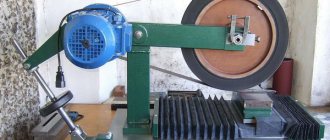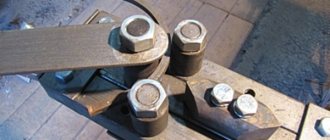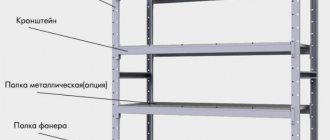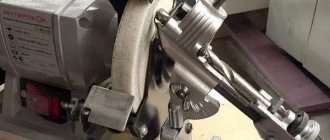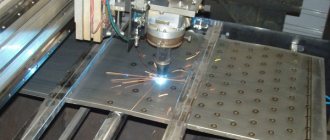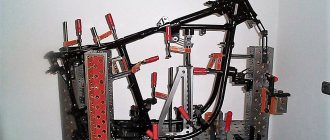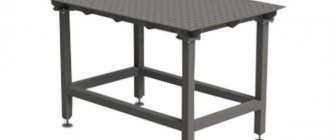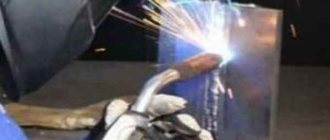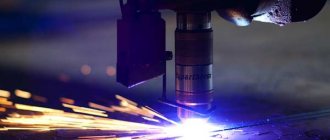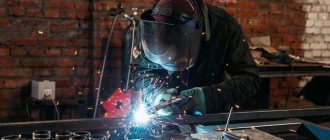Homemade or factory-made welding fixtures hold metal structural components in position and improve positioning accuracy. Equipment is necessary when performing basic and additional steps of the technological process. In serial or mass production, automatic devices are used. In domestic conditions, mechanically driven products are used.
Welding fixtures are needed to provide the most favorable working conditions.
Types of welding equipment
When carrying out welding work, a transformer or inverter is required, connected to an alternating current network with a voltage of 220 or 380 V.
Since the parts are displaced during the joining process and heated to temperatures above +200°C, equipment is required to position and hold the workpieces. Assistive devices are usually divided into categories based on functionality, performance and principle of operation.
By functionality
Equipment can be:
- Universal, designed to work with workpieces of different designs or geometric configurations. It is characterized by reduced dimensions and weight, and is used when checking the correctness of assembly and installation dimensions, as well as when carrying out repair work. Does not provide high performance. Universal devices include clamps or spring clamps.
- Special, designed to perform one operation or used for welding assemblies with uniform design characteristics. Used in large-scale production, it improves quality and reduces welding time. Special equipment includes assembly and welding stands, jigs or templates.
By type of production
The equipment is divided:
- For serial or mass production. It has an increased service life and ensures faster removal and installation of workpieces. The stops are adjustable for the production of metal structures of various configurations.
- For single or small-scale production. Used at home or for welding experimental units. It is not demanding on the speed of installation or removal of workpieces; it is designed for the production of several dozen welded assemblies.
Equipment is divided by type of production.
By nature of work
Equipment is divided into the following types:
- with a manual drive (for example, with a screw or spring clamp or an eccentric);
- mechanized (with power hydraulic or pneumatic cylinders or electric drives), operating under operator control;
- automated (equipped with a mechanical drive and actuator units, the welder needs to configure the sequence of actions and confirm the start of work).
In addition to equipment that operates at standard speed, there is equipment with increased speed that speeds up technological processes.
For mass production, multi-position or carousel-type equipment is used, which reduces the time for installing and removing workpieces.
Devices can be transported or installed on foundations (rigidly fixed in place or moved along guides).
Manufacturing of welding machine
Today it is almost impossible and quite difficult to weld metal or process it in the proper way without using welding equipment. After you make a welding machine with your own hands, you will be able to perform any work with metal products.
Transformer circuit with a separate choke.
To produce a high-quality unit, you must have knowledge and skills that will help you understand the circuit of a DC or AC welding machine, which are two options for assembling equipment.
For home use, it is best to learn how to make mini welding.
It is more convenient to call a specialist or purchase a ready-made unit, but sometimes this can be too expensive, since it is quite difficult to determine the choice of model based on various parameters, such as the weight of the welding machine, and the number of volts per welding machine.
There are several types of welding machines: operating on alternating current, direct current, having three phases or inverter. To choose one of the options and start assembling, you need to consider each circuit of the first 2 types. During the preparatory process, you need to pay attention to the voltage stabilizer.
AC
To make homemade welding machines, you need to select a voltage indicator, the best is 60 volts, the current is best adjusted from 120 to 160 amperes.
You can independently determine the cross-sectional value of the required wire for the manufacture of the primary winding of the transformer, which must be connected to a 220-volt network.
The cross-section according to the area parameters should not be more than 7 mm2, since it is worth noting the possible voltage drop and possible additional load.
Based on calculations, the optimal size of the diameter of the copper core for the primary winding, which reduces the action of the mechanism, is 3 millimeters. When choosing aluminum for the wire, the cross-section is multiplied by 1.6.
It is worth noting that the wires need to be wrapped with a rag, since they must be insulated. The fact is that when the temperature increases, the wire can melt and a short circuit may occur.
If the necessary wire is not available, it is possible to replace it with a slightly thinner wire, winding it in pairs. However, it must be remembered that the thickness of the winding will increase, which is why the dimensions of the welding equipment will be larger. For the secondary winding, a thick wire with a large number of copper cores is used.
DC
Electrical circuit of a DC welder.
Some welding machines operate using direct current. Thanks to this unit, you can weld cast iron products and stainless steel structures.
It may take no more than half an hour to create a DC welding machine with your own hands. In order to convert a homemade product with alternating current, it is necessary that the secondary winding be connected to a rectifier, which is assembled on a diode.
In turn, the diode must withstand a current of 200 amperes and have good cooling. To equalize the current value, you can use capacitors that have certain characteristics and voltage characteristics. After this, the unit is assembled sequentially according to the scheme.
Chokes are used to regulate current, and contacts are used to attach a holder. Additional parts are used to transmit current from an external carrier to the welding site.
Equipment requirements
The equipment used when welding parts must provide:
- Changing the position of the part within the welded unit without the adjustment operation.
- Fast and reliable placement of workpieces in fixtures.
- Maintaining assembly accuracy within the tolerances specified in the design documentation.
- Unobstructed access to welds and parts connection lines.
- Compliance with the dimensions between the ends of the elements being welded.
- Work safety. The equipment is made from materials that are resistant to high temperatures; the application of flammable coatings is not permitted.
- Welding in the lower position to prevent the melt from flowing out of the bath.
- Accelerated heat removal from the working area.
- Protection of moving elements and actuator cylinders from splashes of molten metal and flux.
- Reduced deformation in welding seams.
- Possibility of automating the technological process or mechanizing the transportation of blanks or finished products.
The equipment ensures a change in the position of the part within the welded unit.
Types of auxiliary mechanisms
Various mechanisms and auxiliary parts are made at factories and at home. The simplest of them are easy to make with your own hands. In general, welding aids come in three types:
- mechanisms for installation, assembly, preliminary fixation;
- clamping devices;
- combined devices.
The first type of fixture is used to install parts in the position required for welding. Clamping welding fixtures firmly fix them and prevent them from slipping or turning. Combination devices perform both functions.
The choice of devices is related to the work conditions. It also depends on the requirements for the accuracy of manufacturing workpieces, requirements for clearances, and the design as a whole.
There are certain requirements for auxiliary devices. They must ensure free movement of the parts being welded caused by heating in the welding zone.
If large-sized products are welded, it is necessary to ensure fastening only at the welding points. The welder must be provided with free access to the welding site. It is also necessary to ensure rapid removal of the generated heat.
Cooking devices can be special or universal. For example, a special stand for assembling and welding frame products is a table with clamps.
Universal stands look the same, only they have additional devices for fastening the product, and due to this they can fix a large range of workpieces.
Assembly and welding devices
They are divided into the following categories:
- Installation, allowing the positioning of parts in accordance with the drawing documentation. Depending on the configuration of the workpieces, the products have vertical, horizontal or inclined edges. The devices are rigidly attached to the base, moved along guide grooves or tilted to the side on an axis or hinges. Permanent profile stops are welded or screwed to the welding table. Adjustable brackets are used for parts with uneven geometry.
- Fixing or fastening devices that prevent parts from moving during the welding process (for example, due to temperature deformation or accidental exposure to the electrode). Welders use clamps with a lead screw or cam mechanism. To assemble a metal structure, you must have a set of clamping devices (the size of the pharynx is determined by the dimensions of the workpieces).
Ties
The coupler is a threaded bushing that allows you to adjust the distance between the mating edges. To install a bolt, brackets with nuts or holes with threads inside are temporarily installed on the parts.
We recommend reading Description of the welding transformer
For example, a welding square is used when connecting pipes made of carbon steel. There are couplers with clamps that are placed on the outer surface of cylindrical parts and secured with screws. The design does not provide rigid fastening of the parts to be connected.
Tacks
A clamp is a small piece of reinforcement or steel profile that is used to temporarily connect large parts.
To change the position of the parts, adjustable elements (with a threaded bushing) are used.
After filling the joint with molten metal, the clamps are cut off or integrated into the structure of the seam.
Jacks and spacers
Rack jacks and rods with a screw section are necessary for holding metal structural elements with a closed profile and for aligning the mating edges of cylindrical workpieces.
The devices are used to straighten dents on the surface. When connecting pipes, spacers are used in conjunction with external clamping rings, which increases the accuracy of the joints.
Jacks can be equipped with a mechanical drive.
There are products with hydraulic or pneumatic cylinders connected to an external pump or compressor station.
Centralizers
If, when welding workpieces that have an axis of rotation, it is necessary to hold the parts in 3 planes, then centralizers are used. They allow you to align the outer surfaces and the center line.
Workpieces are held by gripping the outer or inner parts. The equipment has a mechanical drive of the executive body. Centralizers for large-sized pipes are equipped with hydraulic cylinders.
Brief description of the operation of the centralizer TsNG-1120:
- Align adjacent sections of the pipeline.
- Place a double roller chain on the joint line.
- Connect the hydraulic drive to an external pumping station with a spool valve.
- Turn on the fluid supply and wait for the outer edges to align evenly.
- Weld the seam through the gap between the chain sections.
- Release the force and then move the device to the next joint line.
Centralizers hold parts in 3 planes.
Useful tricks and secrets of electric welding
Every experienced welder will say that performing welding work takes much less time and effort than carrying out preparatory work for it. To perform welding work, you will need a certain number of additional tools. The initial stage of preparation for welding work consists of purchasing all the necessary equipment and fixtures. Such equipment includes:
- Welding equipment.
- Electrodes.
- Hammers designed to beat away the resulting slag.
- Special brush.
You should also not forget about your own safety. After all, welding activities take place in conditions of elevated, extreme temperatures. Therefore, before starting to weld surfaces, the welder should wear gloves made of suede, high-density clothing (with long sleeves that will completely cover the hands), as well as a welding mask equipped with a light filter. Also, especially for novice welders, you need to remember that the type (diameter) of the electrode for welding work must be selected based on the thickness of the metal surface being welded. If the thickness of the steel is 1.5 mm, then to weld it you need an electrode with a diameter of 1.6 mm; for steel with a thickness of 2-3 mm, electrodes with a diameter of 2.5 mm are perfect.
On a note! Each electrode is equipped with a special coating. When it melts, a gas zone appears in the arc area. Due to this, during welding, oxygen is displaced and does not come into contact with the metal.
To get an even, beautiful welding seam, novice welders are recommended to watch special video lessons that are devoted to all stages of welding work, which tell about all the tricks and secrets of their implementation. Immediately before welding metal parts, they must be securely fixed. Welding work should not be carried out on wooden surfaces, which could catch fire due to excessively high temperatures. Also, after completion of welding work or during its implementation, it is necessary to constantly remove the remnants of already used electrodes from the working surface.
When welding metal surfaces, it is enough to light an arc. To do this, you need to take the electrode, using the holder, select the current power required for welding, and then place it in relation to the product being welded at an angle of approximately 60 degrees. Then, holding the electrode, they need to be moved slowly, in a zigzag, oscillatory motion, along the surface to be welded. When sparks appear, you can touch the metal surface to be welded with the electrode, and then you need to lift it, but no more than 5 mm from the part (surface) to be welded.
Reference! During welding activities, until their completion, when welding surfaces, the electrode used must be held from the working surface at a distance of 5 mm. When welding metals, the electrode used gradually burns out. If during the welding process the electrode sticks to the metal, then it must be turned to the side without using force. If you can’t light the arc, then you need to slightly increase the current.
After performing welding work, it is imperative to remove and knock off the accumulated slag from the workpiece, welded part, using a special hammer (if you don’t have one, you can take a regular one). To replace the used electrode with a new one, it is necessary, in order to comply with safety regulations, to turn off the welding machine. After replacing the electrode, you need to make a 12 mm indentation from the old seam, and then light the arc.
Stands for welding and assembly
Several types of stands are used to connect parts:
- flat slabs;
- racking systems for the production of volumetric metal structures;
- conductors and templates;
- devices for holding parts in the required position during welding.
Shelving and slabs
To connect flat workpieces, plates assembled from sections of steel profile are used. The top edge of the guides forms a flat surface. The parts are fixed using replaceable or rigidly attached stops to the base.
Equipment is divided into stationary, portable and overhead (installed on work tables or beds). The rack is distinguished by the use of inclined surfaces with replaceable supports. It is made of a steel profile that allows you to connect power from a welding transformer.
Algorithm for using a rack when welding a T-shaped beam from flat workpieces:
- Place the stops in the required position and install the elements at the required angle.
- Go through the joint line with a welding tractor or semi-automatic machine.
- Turn the structure over and sew the seam on the other side.
Conductors
The device consists of a frame (with stops and fasteners) mounted on a swinging axis. The jig allows you to install parts in the required position.
The operator then welds the metal structure, changing the installation angle. A device is provided to hold a bath of molten metal and flux in the work area. This allows you to get a strong seam without tears or internal voids.
Adjustable stops are used on the conductors; it is possible to use a welding tractor to automate the assembly process.
In this case, auxiliary components should not interfere with the movement of the equipment.
The tilt angle can be changed manually or electrically. The equipment is used in the serial production of welded structures. In artisanal conditions, conductors are rare.
Fasteners
To firmly hold metal structure parts in a given position, removable or stationary clamps are used, which have different configurations and methods of attachment to the desktop.
Clamps are needed to firmly hold parts.
For example, in the manufacture of products, removable brackets are used to take into account differences in the geometric dimensions of the workpieces.
To connect parts to machined surfaces, rigidly fixed or adjustable prisms are used, and for mass production, a reusable template is installed on the table, defining the outline of the welded structure.
Templates
They are rigidly installed guides that hold several parts in the required position. After welding, the resulting assembly is removed for machining or installation of additional elements using other equipment. Since the cost of manufacturing a template is higher than that of adjustable stops, the technology is used in mass production or for welding individual non-standard structures (the price of the equipment is included in the price of the product).
Stops
Folding or fixed stops keep parts from moving to the side; units are used in jigs and on shelving. Stops are usually divided into limiting (or force) and guides (they do not experience load from the weight of the parts). The brackets are installed with screws (with the ability to move along grooves cut in the base) or welded to the rack.
Stops keep parts from moving.
Clamps
Pressure plates are designed to hold flat or shaped workpieces and have a mechanical or power drive (hydraulic, electromagnetic or pneumatic).
We recommend reading: How to choose a gasoline welding generator
The manual device consists of a bracket (welded to the base or moving along a guide slot) and a screw with a handle. After installing the workpieces, the operator tightens the clamp and begins welding.
Devices with a spring-loaded rod or with a rotating eccentric head mounted on a bracket have become widespread.
DIY welding crafts
With the help of the most ordinary welding, you can make many interesting homemade products. For example, from available materials you can make a model of a New Year tree, which will become an excellent decoration both in the house and in the workshop. To make the simplest homemade model, you will need to take a piece of pipe and a square steel plate.
A large piece of pipe 1.5 m long will serve as the base of the layout. Then you need to take another piece of tube of the same diameter. It is necessary to cut it into 9 identical pieces 4-5 centimeters long. Then these sections must be welded along the entire length of the main pipe (in a circle, in three tiers). Platinum should be welded to the base of the model to make it stable. All the homemade stuff is ready. In winter, you can go into the forest, cut simple spruce branches, put them in tubes and the Christmas tree will be ready.
Equipment for installations
Welding installations use additional technological equipment:
- Baths for holding molten flux, preventing the penetration of foreign impurities into the metal, reducing the strength of the joint. Used when it is impossible to protect the weld using standard methods. For example, when welding vertical sheets with an overlap, a corner is installed that does not allow liquid flux to flow down the surface. Baths can be mobile or stationary.
- Flux pads that prevent molten metal from flowing out through the gap between the sheets. The protective layer is pressed against the lower edge of the workpiece, holds the weld pool and forms a reverse seam bead.
Laying and edging of products
When welding large-sized workpieces, it becomes necessary to rotate and move the assembled unit. There are roller-type and lantern-type tilters.
There are installations with levers or chain grips. The parts are fixed in a given position using manual or mechanical drives, after which the operator begins to weld the seams.
The equipment is equipped with fixed or adjustable stops and clamps, and universal manipulators are produced that allow you to work with workpieces of different sizes.
Roller beds
Roller machines are designed for welding cylindrical elements. The wheels are equipped with a rubberized rim to improve contact. One of the rollers is power driven by an electric motor or manual gearbox; the remaining supports are necessary for positioning the parts in space.
Roller beds are designed for welding cylindrical parts.
To connect conical blanks, the bases of the rollers are equipped with regulators necessary to change the angle of the wheels.
Rotators for products
A rotator (or carousel) consists of a work table with a vertical, inclined or horizontal axis that does not change its position in space. The workpieces are mounted on the surface using clamps; the rotation speed depends on the welding speed and the characteristics of the technological process. To drive the rotary unit, electric motors with gearboxes and hydraulic motors are used (rotation speed depends on fluid pressure).
Universal manipulators
To position welded structures in the industrial cycle, universal stationary equipment is used, equipped with a cast or welded frame with rigid attachment to the foundation slab. Inside the frame there are electric drives, a transformer and mechanisms for supplying inert gas and filler wire. The workpieces are placed on a work table or faceplate with dovetail grooves intended for mounting stops or clamps.
Universal manipulators are used to position welded structures.
The faceplate is equipped with sectors with gear rims and is mounted on a hinge that allows table deflection. Some manipulators are equipped with a surface height adjustment system. There are budget manipulators with manual control used for small-scale production.
Positioners for edging
Designed to rotate installed workpieces into a position that provides access for the electrode or welding head to the joint line. The equipment consists of a frame and a manipulator with a manual, electric or hydraulic drive. The parts are mounted on the surface of a faceplate, which can be rotated in several directions (manually or according to a stored program).
A standard positioner can move the weld assembly around an axis to weld parts along the top and bottom surfaces, and also raise and lower the product to fill joints on the sides with metal. Manual units are equipped with gearboxes with stoppers that reduce the load on the operator during operation. When the mass of workpieces is more than 1500 kg, an electric drive with a constant speed of movement is used (no movement speed controllers are provided; the seam is performed by moving the electrode or head along the line of connection of the parts).
Devices for rotation and fastening of equipment
In automatic or semi-automatic welding, special installations are used that allow the head with the electrode to be moved vertically or horizontally. The equipment consists of a rack and boom that are adjustable in size, and there are points for attaching power cables and hoses for supplying inert gas. The welding tractor moves along the surface of the parts to be joined in accordance with the program, but special trays or brackets are provided to hold the electrical wiring.
When welding, the head with the electrode moves automatically.
Purpose and classification of devices
Purpose and classification of devices
Welding fixtures are additional technological devices for equipment used to perform assembly operations for welding, welding, thermal cutting, soldering, surfacing, eliminating or reducing deformations and stresses, as well as for control. In complex mechanized welding production, loading, unloading, lifting and transport and combined devices are widely used.
Assembly and welding equipment is a set of devices and special tools for performing plumbing, assembly, installation and other types of work. Therefore, the term “equipment” is more often used in shipbuilding, installation, and construction. The use of welding devices can reduce the labor intensity of work; increase labor productivity; reduce the duration of the production cycle; improve working conditions; improve product quality; expand the technological capabilities of welding equipment; contributes to increased comprehensive mechanization and automation of production and installation of welded products. Welding fixtures are classified according to several criteria (Fig. 1) as follows: according to the technological process operations performed in welding production - fixtures for marking, thermal cutting, assembly for welding, welding, combined (assembly-welding, blanking-assembly-welding, etc. ); for quality control; heat treatment; edits; mechanical (for installation, rotation, feeding, transmission, removal of products or parts, lifting and moving the welder, installation, rotation and movement of an automatic or semi-automatic welding machine); lifting and transport; by type of processing and welding method - devices for electric arc welding (manual, semi-automatic and automatic); electroslag welding; resistance welding; surfacing; rations; thermal cutting, etc.; by degree of specialization - special devices designed to perform one specific operation during
production of specific components in serial and mass production;
reconfigurable (group), used to perform this operation for
groups of similar products that are similar in design and technological parameters in small-scale production; universal, designed to perform assembly and welding operations in single and small-scale production;
Rice. 1 .
Classification of welding production devices
by level of mechanization and automation
- hand tools,
mechanized, semi-automatic and automatic;
by type of installation
- stationary, mobile and
portable; as necessary and possible to rotate
— devices
fixed and rotary. according to the source of energy for the drive of rotation, movement, clamping of parts
— pneumatic, hydraulic, pneumohydraulic, electromechanical, magnetic, vacuum, centrifugal-inertial, combined devices (in large-scale and mass production, special devices are used, mainly with a pneumatic drive).
In conditions of mass production, it is necessary to increase productivity and facilitate the work of workers, and therefore special devices with high-speed mechanisms for loading, installing, clamping, unloading, turning, etc. are used. They are often built into flow-mechanized and automated lines. In individual production and installation, simple, universal, portable devices with screw, cam, wedge, spring and electromagnetic clamps are used.
Requirements for welding fixtures
The design of welding fixtures requires a whole range of
requirements:
— ease of use (implies accessibility to places where parts are installed, clamping devices and control devices, places where tacks and welds are applied, comfortable postures for the worker, a minimum of bending and walking, and other requirements for the scientific organization of labor);
— ensuring the specified sequence of assembly and sutures in accordance with the developed technological process;
— ensuring the specified quality of the welded product (the device must be sufficiently strong and rigid, and the fastened parts must remain in the required position without deforming them during welding);
— the possibility of using standard, unified, normalized and standard parts, assemblies and mechanisms in the design and manufacture of welding fixtures (this helps reduce the cost of the fixtures, the timing of their design and manufacture, increase maintainability, etc.).
— ensuring the assembly of the entire structure from one installation, the smallest number of turns during assembly and tack (welding), free removal of the assembled and welded (tack) product or mounting device;
— ensuring rapid heat removal from the welding site to reduce warping, a given angle of rotation of the product, free installation and removal of the product, free access for inspection, adjustment and control;
— manufacturability of parts and components of the device, as well as the device as a whole;
— the use of mechanisms for loading, feeding and installing parts, removing, pushing and unloading the assembled product, and using other means of complex mechanization.
When developing devices and equipment, one should be guided by the principles of artistic design, machine shaping, as well as ergonomic requirements. It is necessary to determine the optimal working posture of the operator and the size of his workplace, to have a good idea of the specific actions of a person, his connections with the machine. In complex cases, it is necessary to prepare models or mock-ups in order to test options for compositional solutions, analyze known technical solutions when designing devices, and widely use the experience of other enterprises and organizations.
Vacuum clamps - their calculation
Rice. 31. Schemes of vacuum clamps driven by a pneumatic cylinder (a) and from
vacuum pump (b)
In vacuum clamps, thin-walled parts are secured under excess atmospheric pressure, which occurs due to vacuum in the vacuum cavity (Fig. 31). This vacuum can be created by a vacuum cylinder 3
(Fig. 31,
a),
connected by a channel to a vacuum cavity
6.
The tightness of the cavity
6
is ensured by a rubber gasket 7 installed
in the case 2
devices.
The pneumatic cylinder 4,
connected to the vacuum cylinder
3,
is controlled by a distribution valve
5,
to which compressed air is supplied from the workshop pneumatic network.
The clamping force W
of part
1
will be
W
= (
pa
-
p o
)
F
-
p y
where pa is atmospheric pressure, MPa;
po—residual pressure in the chamber after vacuum: po = 0.0] ... 0.015 MPa;
F
- area limited by the internal contour of the rubber gasket;
ru—elastic force of a compressed rubber gasket, N.
To securely fasten the part, it is necessary that 0.07 0 p
—
p
³
a
MPa. In the working chamber, rho = 0.01 ... 0.015 MPa is sufficient, since creating a deeper vacuum is expensive and ineffective.
In clamps that have a vacuum pump and operate according to the scheme in Fig. 31, b,
The part 1 is pressed against the body
2
by creating a vacuum in the cavity
6.
the distribution valve
3
connects the vacuum chamber
6
with the vacuum pump 5 and the receiver
4.
To release the part, the distribution valve connects the vacuum cavity of the device to the atmosphere.
Electromechanical clamps
Electromechanical clamps are silent in operation, durable, have low operating costs, are relatively fast and provide self-braking.
The electromechanical clamp (Fig. 32) consists of an electric motor 1, a gearbox 2
and a screw pair 5 and
6.
From the electric motor 1, rotation is transmitted through the safety clutch
3.
the screw
5
rotates, it moves the nut
6
to the right or left, and with it the rod
7,
the clamping force of the part
8 through the lever 9.
When the required force is achieved, the torque on the electric motor shaft and the current increase significantly and current relay
4
turns off the engine.
Traction force
where N is the power of the electric motor; h — gearbox efficiency, i
— gear ratio;
n
—motor rotation speed, min-1; rср—average radius of the screw thread, cm, a—height angle of the screw thread, degrees; j is the friction angle in the threaded connection, degrees.
Rice. 32. Electromechanical drive diagram
Purpose and classification of devices
Welding fixtures are additional technological devices for equipment used to perform assembly operations for welding, welding, thermal cutting, soldering, surfacing, eliminating or reducing deformations and stresses, as well as for control. In complex mechanized welding production, loading, unloading, lifting and transport and combined devices are widely used.
Assembly and welding equipment is a set of devices and special tools for performing plumbing, assembly, installation and other types of work. Therefore, the term “equipment” is more often used in shipbuilding, installation, and construction. The use of welding devices can reduce the labor intensity of work; increase labor productivity; reduce the duration of the production cycle; improve working conditions; improve product quality; expand the technological capabilities of welding equipment; contributes to increased comprehensive mechanization and automation of production and installation of welded products. Welding fixtures are classified according to several criteria (Fig. 1) as follows: according to the technological process operations performed in welding production - fixtures for marking, thermal cutting, assembly for welding, welding, combined (assembly-welding, blanking-assembly-welding, etc. ); for quality control; heat treatment; edits; mechanical (for installation, rotation, feeding, transmission, removal of products or parts, lifting and moving the welder, installation, rotation and movement of an automatic or semi-automatic welding machine); lifting and transport; by type of processing and welding method - devices for electric arc welding (manual, semi-automatic and automatic); electroslag welding; resistance welding; surfacing; rations; thermal cutting, etc.; by degree of specialization - special devices designed to perform one specific operation during
production of specific components in serial and mass production;
reconfigurable (group), used to perform this operation for
groups of similar products that are similar in design and technological parameters in small-scale production; universal, designed to perform assembly and welding operations in single and small-scale production;
Rice. 1 .
Classification of welding production devices
by level of mechanization and automation
- hand tools,
mechanized, semi-automatic and automatic;
by type of installation
- stationary, mobile and
portable; as necessary and possible to rotate
— devices
fixed and rotary. according to the source of energy for the drive of rotation, movement, clamping of parts
— pneumatic, hydraulic, pneumohydraulic, electromechanical, magnetic, vacuum, centrifugal-inertial, combined devices (in large-scale and mass production, special devices are used, mainly with a pneumatic drive).
In conditions of mass production, it is necessary to increase productivity and facilitate the work of workers, and therefore special devices with high-speed mechanisms for loading, installing, clamping, unloading, turning, etc. are used. They are often built into flow-mechanized and automated lines. In individual production and installation, simple, universal, portable devices with screw, cam, wedge, spring and electromagnetic clamps are used.
Requirements for welding fixtures
The design of welding fixtures requires a whole range of
requirements:
— ease of use (implies accessibility to places where parts are installed, clamping devices and control devices, places where tacks and welds are applied, comfortable postures for the worker, a minimum of bending and walking, and other requirements for the scientific organization of labor);
— ensuring the specified sequence of assembly and sutures in accordance with the developed technological process;
— ensuring the specified quality of the welded product (the device must be sufficiently strong and rigid, and the fastened parts must remain in the required position without deforming them during welding);
— the possibility of using standard, unified, normalized and standard parts, assemblies and mechanisms in the design and manufacture of welding fixtures (this helps reduce the cost of the fixtures, the timing of their design and manufacture, increase maintainability, etc.).
— ensuring the assembly of the entire structure from one installation, the smallest number of turns during assembly and tack (welding), free removal of the assembled and welded (tack) product or mounting device;
— ensuring rapid heat removal from the welding site to reduce warping, a given angle of rotation of the product, free installation and removal of the product, free access for inspection, adjustment and control;
— manufacturability of parts and components of the device, as well as the device as a whole;
— the use of mechanisms for loading, feeding and installing parts, removing, pushing and unloading the assembled product, and using other means of complex mechanization.
When developing devices and equipment, one should be guided by the principles of artistic design, machine shaping, as well as ergonomic requirements. It is necessary to determine the optimal working posture of the operator and the size of his workplace, to have a good idea of the specific actions of a person, his connections with the machine. In complex cases, it is necessary to prepare models or mock-ups in order to test options for compositional solutions, analyze known technical solutions when designing devices, and widely use the experience of other enterprises and organizations.
Work area equipment
Depends on the nature of the welding work performed and the size of the workpieces. For example, when welding large structures, knee lifts with a cradle for the operator and equipment are used. The units can move along guides or along the ground surface; for control, there is a remote control in the basket.
The drives are equipped with AC motors, some of the actuators are equipped with pneumatic or hydraulic cylinders.
In domestic conditions, a metal table is required, equipped with screens to protect against hot drops of metal and slag. They provide a chair for the welder and a set of devices for fixing parts. Work on flammable floor coverings is not permitted. The walls of the room are painted with light gray materials (to absorb the ultraviolet spectrum). Above the table there are lamps (lighting level from 80 Lux) and a hood with an electric fan (capacity 40 m³/hour).
We recommend reading Features of setting up the Chameleon welding helmet
Pipe welding devices
Pipeline welding equipment ensures the centering of mating products and maintains a uniform gap between the edges. There are devices for straight lines and corner branches. The design of the product includes clamps and additional clamps installed on movable rods or chains.
There are special devices for welding pipelines.
For example, to use a simple straight pipe device, the welder must:
- Move the workpieces with pre-prepared edges.
- Place clamps on the outer parts of the pipes and tighten the screws.
- Adjust the gap by rotating the bolt connecting the brackets to the clamps.
- Fill the joint with molten metal, and then remove the equipment and clean the surface of the joint from scale and slag.
Clamps and tightening devices
Clamping devices play an important role. They press workpieces to clamps or tooling planes, and are mechanical, pneumatic and magnetic.
Mechanical clamps are very simple in design, therefore they are the most common. They are reliable, rarely fail and are inexpensive. Mechanical devices are wedge, screw and spring. Wedge clamps are usually used when aligning the edges of a product, when pressing the contacting parts of the parts being welded.
But the most common and universal devices are screw clamps, they are also called clamps . They are used mostly for single production and in the household, and require a lot of installation time. Spring clamps are used when welding small and thin workpieces.
Pneumatic devices can be used as welding aids. They have high performance, are distinguished by accuracy and a “death grip”.
Since compressed air is elastic, the device provides gentle compensation for deformations occurring during welding. Pneumatic systems are used mainly in mass production with a high level of mechanization. Hydraulic clamping systems are used to grip and press heavy parts (1 ton or more).
Magnetic clamps (also called holders) are easy to use and quickly installed and removed. They are used to align edges and press flat products to the base of the stand through a flux pad. In enterprises, electromagnetic clamps are most widely used, while permanent magnets are popular in private use.
The tightening devices include all kinds of ties, spacers and jacks. They have a wide variety of devices, sometimes quite complex designs, and are used to tighten and expand workpieces during the welding process.
Magnetic devices
For household and industrial welding, assembly and welding fixtures with permanent magnets are often used. For example, there are templates with surfaces located at different angles (fixed or variable). The products allow you to position sections of profile pipes or connect sheet steel workpieces. Magnetic clamps are not used when welding parts made of stainless steel or non-ferrous metals.
Universal equipment from MagTab or V-Pads is equipped with several surfaces with the ability to smoothly adjust their relative position. The operator needs to attach the product to the surfaces of the parts, ensure correct positioning, and then begin welding.
Equipment allows you to reduce the time spent on work and improve quality. The strength of the magnets ensures the immobility of the connected elements.
Devices with magnets
Magnetic clamps are classified as installation and fastening mechanisms. This means that they allow you to correctly position the parts and secure them. This operation is carried out using strong magnetic elements.
What advantages does this welding device provide? Let's figure it out.
Welding using magnetic corners.
The main advantages include:
- the ability to quickly connect parts;
- installation of parts at different angles using a magnetic angle for welding;
- significant reduction in time for preparatory work;
- small dimensions;
- the presence of a magnetic field activator in some models;
- possibility of quick and easy cleaning of magnets.
The main disadvantage of such devices is the limitation of their use depending on the material. Non-magnetic metals, wood, etc. do not allow the use of magnets.
On the other hand, magnetic welding fixtures allow you to fasten parts at any angle to each other, and they are more versatile than, for example, clamps.
Magnetic clamps are truly convenient mechanisms that eliminate bulky clamps and the need for resistance welding.
In addition, on the Internet you can find a large number of reviews devoted to the manufacture of homemade devices for welding work. For example, you can make your own magnetic square for welding with your own hands or a magnetic mass for welding.
Auxiliary Tools
When welding parts, additional tools will be required:
- Hammers with a special striker and brushes with metal bristles, used to remove slag from the surface of the weld. To remove large fragments of flux and remove excess metal, use chisels.
- A measuring tool (square, tape measure, caliper) necessary for transferring drawing dimensions to workpieces. Lines are drawn with a marker, lump chalk or a metal rod with a pointed tip.
- Angle grinder with a protective casing and a set of discs for cutting metal, used when cutting workpieces. A hacksaw is used to cut profiles with a small cross-section. An electrically driven abrasive tool is used to clean edges before welding, as well as seams.
Wire brushes are used to remove slag.
What devices are used for home welding?
In domestic conditions, inverters and compact equipment with a welding torch and an inert gas supply system are used. The master needs to purchase a protective mask, mittens and clothing that protects the skin from burns. To remove scale, you will need a hammer and a metal brush; to fix the parts, use a magnetic square with adjustable edges (ranging from 30° to 135°). The equipment is selected according to the power of the magnets. For domestic purposes, a force of 8-12 kg is sufficient; for large workpieces, a device with a force of 30-35 kg will be required.
Clamps, universal clamps with a manual drive, are suitable for household use; they allow you to secure metal structural elements in the required position and reduce the deformation of parts during heating and cooling. If you plan to connect metal pipes, then centralizers with a clamp (for example, SM-151 or TsSZ) are used at home.
Making a magnetic holder
If you are interested in assembly and welding fixtures, you can make them yourself, rather than purchasing factory-made options. This also applies to the magnetic holder, for which you need to prepare the following materials:
- sheet metal;
- dry board;
- magnetic fastener.
When preparing metal, it is necessary to be guided by certain parameters; the thickness of the sheet can vary from 1 to 3 mm. When creating a template for a future design, it is better to make a monolithic version, the dimensions of which will correspond to the needs of the master. The template must be attached to the sheet metal and identical blanks must be cut out in the amount of 2 pieces. It is important to preserve their geometry.
It is best to draw up drawings of welding fixtures yourself; you can find some of them in the article. The next step towards making magnetic devices is to prepare the central part of the magnet. To do this, you need to cut a piece of wood according to the shape of the metal plates, but its size should not completely repeat the template. You should retreat 2 mm from the edges. The thickness of this element should be 2 mm greater than the width of the magnets.
The outer part of the product is ready at this stage, now you need to create the internal filling. In this case, you should push away from the magnets. They will be located between the plates, and the thickness can vary from 10 to 50 mm. When making such a device for welding at an angle, it is better to use round magnets, each of which will have holes in the central part. However, other workpieces can be used for work, which are pre-prepared by cutting holes for installing fasteners. The final stage will be drilling holes and assembly. Steel plates are fastened on both sides with a wooden blank, and magnets are fixed in the grooves. At this point, we can assume that the product is ready; it should be tested in practice.
Is it possible to make something with your own hands?
The welder can assemble auxiliary equipment with his own hands, using available materials. For example, homemade devices for welding pipes are assembled from scraps of corners and clamps for carpentry or plumbing. Installing the stops at right angles allows you to assemble a simple jig for making a batch of welded structures (frames for installing grilles in windows or making fence sections).
A brief algorithm for manufacturing the simplest equipment for welding:
- Cut rectangular blanks from scrap profiles or sheets 5-10 mm thick using an abrasive tool.
- Process the edges manually or on a milling machine, remove traces of paint and corrosion from the surfaces.
- Attach the stops to the base (for example, to a metal workbench or channel rack), taking into account the relative position of the parts.
To make a magnetic stop, you need to cut out 2 symmetrical templates, which are attached to the sides of the magnet with a central hole with bolts. The location of the screws does not allow the plates to move relative to each other. The emphasis is placed on the first part, and the second element is placed along the side surface of the template. Then the components are connected by several welding points, the stop is removed and the seam is completely welded on both sides.
There are homemade templates cut from a steel plate with subsequent processing of the edges on a milling machine. The workpiece is placed on the base and additional stops are installed to limit mobility. Welders use makeshift clamps made from profile scraps and bolts with nuts. There is no single standard for homemade equipment; each master develops devices, focusing on experience and taking into account the specifics of the work performed.
Making pliers
Homemade welding devices also include pliers. You can collect them, but you need to be patient. To carry out the work, you should prepare a copper dart, the length of which is 2 m. Its diameter should be 30 mm. This workpiece may turn out to be slightly longer, in which case it will be possible to bend it. The element is bent to form a horseshoe-shaped blank. 18mm holes are made at the ends, then you need to turn them around and make a cut.
The result will be clamps for the electrodes. Two transformers are connected in parallel, in which the secondary and primary windings must be connected directly. The current supply can be adjusted independently. Such homemade welding devices must be cooled, and water should be used for this. By using the foot pedal you can remove the electrodes.
